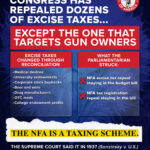
Mark Carlson walks past a gun rack holding his firearms at his home in Hammond, Wis., Wednesday, Sept. 28, 2022. "I'm not a big gun guy," says Carlson, whose weapons include pistols, a shotgun, an AR-15 rifle, 10 loaded magazines and about 1,000 additional rounds. "For a lot of people that's just a start." (AP Photo/David Goldman)
When proposing the Fourteenth Amendment to Congress in 1866, Senator Jacob Howard referred to “the personal rights guaranteed and secured by the first eight amendments of the Constitution; such as freedom of speech and of the press; … the right to keep and bear arms….” He averred that “the great object” of the amendment was “to restrain the power of the States and compel them at all times to respect these great fundamental guarantees.” The design was not to change the nature of the rights, but to prevent the states from violating them.
The Second Amendment was ratified in 1791, and the Fourteenth Amendment was ratified in 1868. The Supreme Court stated in D.C. v. Heller (2008) and repeated this year in N.Y. York State Rifle & Pistol Ass’n v. Bruen: “Constitutional rights are enshrined with the scope they were understood to have when the people adopted them.” So do we look for that understanding in 1791 or in 1868? …
In short, there is only one Second Amendment. It means what it meant in 1791. Although analysis of attitudes in 1868 is relevant to determining whether the Second Amendment is incorporated, that does not change the fact that what was incorporated was the pre-existing right to keep and bear arms. Post-1868 evidence cannot be used to contradict that original understanding.
Stephen Halbrook in Did the Fourteenth Amendment Alter the Meaning of the Second Amendment?






